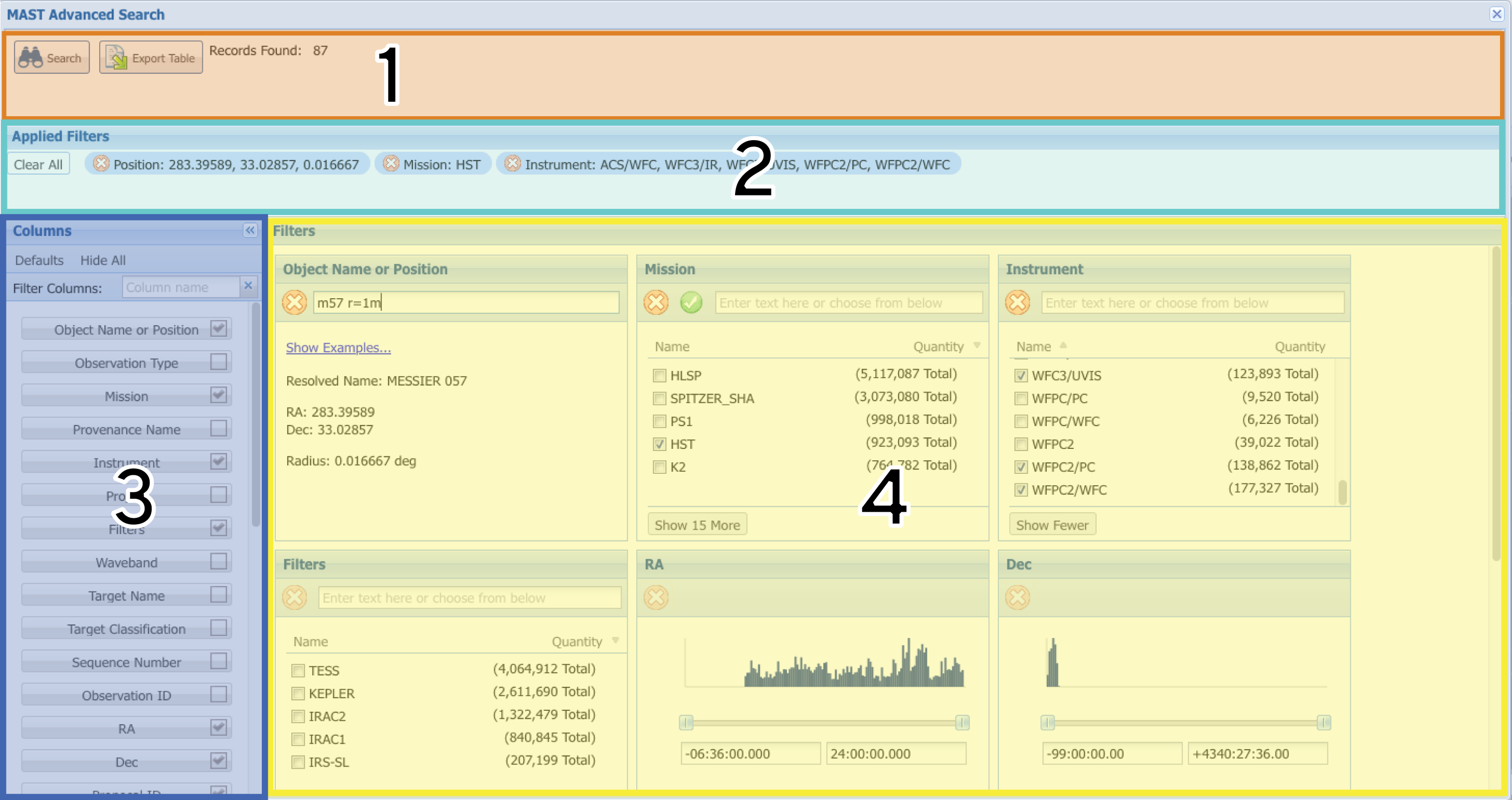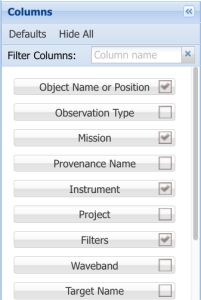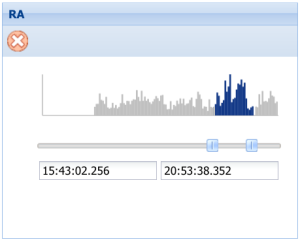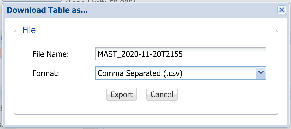On this page:
The Advanced Search Window
Advanced searches, using an expanded set of metadata, are provided for certain MAST data collections, including the default search of MAST Missions. Clicking the Advanced Search link below the Portal target name/coordinates dialog box will bring up the MAST Advanced Search window, which is shown below.
The Advanced Search Window consists of metadata filters which may be used to constrain the search results. The number of matches to observations with the applied filters is displayed (1: top), the Applied Filters panel displays the names and values (2: second from top), the available filter Columns panel (3: lower left), and the selected dialogs in the Filters Panel (4: lower right).
Applied Filters Panel
Filters for which values or ranges have been applied are summarized in the Applied Filters Panel. Filters may be removed individually, or with the Clear All button. Specific filters may be selected in the Columns Panel; values or ranges of values may be set in the individual Filter dialogs.
The term "filters" is, unfortunately, overloaded. Astronomers often think of filters as passband-limiting optical elements. In this context, filters are used to select a subset of available results using one or more criteria.
Search Parameters
The Advanced Search enables custom searches with a wider variety of criteria that may, but do not necessarily, include a target name or coordinates (as with Basic Search). As criteria are applied, preliminary searches will be performed in the background to update the Records Found count at the top of the window. This helps narrow the search to a manageable number of results.
The count of search results must be <50,000 to load the results into the MAST Portal, or <500,000 to download the results to a local file.
Search criteria are specified by:
- selecting one or more available filters in the Columns panel, and
- specifying the values (or range of values) in the corresponding dialogs in the Filters panel.
Columns Panel
Filters Panel
Filters dialogs come in three flavors depending upon the type of parameter, as described below.
Enumerated Filters
Text Filters
Filter Ranges
Available Filters
About 30 filters are available for restricting search parameters. They map to user-accessible metadata in the MAST CAOM (Common Archive Observation Model) database.
| Column Name | Field Type | Description |
|---|---|---|
Object Name or Position | Text | Search for a given target name or coordinates, which is analogous to the primary search Portal search bar (see Basic Search). The coordinates are assumed to be Equatorial in the ICRS reference frame (epoch J2000). |
| Observation Type | Enum | Restrict the search to 'science' or 'calibration' observing programs. Note that on-sky calibration exposures may have some science value. |
| Mission | Enum | Name or acronym for the mission that obtained the data. High-Level Science Products are collected in the 'HLSP' mission. |
| Provenance Name | Enum | Identifier of the software or team that produced the data. For HST and JWST mission data the mission corresponds to the calibration pipeline that produced the data. |
| Instrument | Enum | Acronym for the science instrument used to obtain the data. |
| Project | Enum | Similar to the 'Mission' field (identical in most cases) but reflects the originating mission, e.g. HST-based HLSPs will have 'HST' in this field. |
| Filters | Enum | Select one or more names of optical elements (i.e., filters, gratings). |
| Waveband | Enum | Designation of wavebands (broadly defined). |
| Target Name | Text | Target name or field as specified by the PI in the observing program. |
| Target Classification | Enum | Target classification in the STScI proposal database, such as 'STAR' or 'GALAXY'. |
| Sequence Number | Text | The meaning is specific to a missions, e.g. the Sector number for TESS observations. |
| Observation ID | Text | Search for a specific observation ID, or similar observation ID's using wildcards. |
| RA | Range | Specify a range of Right Ascension for the target position. Values are displayed in sexagesimal but can be entered in degrees. |
| Dec | Range | Specify a range of Declination for the target position Values are displayed in sexagesimal but can be entered in degrees. |
| Proposal ID | Text | Specify a proposal/program ID number. Wildcards are allowed. |
| Principal Investigator | Text | Filter on certain Principal Investigator names. Wildcards are advised. |
| Product Type | Enum | Specify certain data product types, such as 'image' or 'spectrum'. |
| Calibration Level | Enum | Filter on numerical calibration levels assigned to observations. High-Level Science Product (HLSP) data are designated Level 4, while planned-but-not-executed observations are Level –1. The meaning of a level is mission-specific. |
| Start Time | Range | Specify a range of start date-times (in UTC) for the matched exposures. |
| End Time | Range | Specify a range of end date-times (in UTC) for the matched exposures. |
| Exposure Length | Range | Specify a range of exposure duration in seconds. |
| Min. Wavelength | Range | Specify a range of lower-bound wavelengths in nm. |
| Max. Wavelength | Range | Specify a range of upper-bound wavelengths in nm. |
| Observation Title | Text | Filter on specific proposal titles. Wildcards are advised. |
| Release Date | Range | Specify a range of data release dates (i.e., when the data become public). For Exclusive Access data, this date may be in the future. |
| Proposal Type | Enum | Filter on specific proposal types, such as 'GO' or 'SNAP'. The appropriate types will vary by mission. |
| Data Rights | Enum | Filter for 'PUBLIC' or 'EXCLUSIVE_ACCESS' data permissions (or 'PROPRIETARY' but this is being phased out going forward). |
| Moving Target | Enum | Use this boolean flag to filter moving targets. |
| Product Group ID | Text | Filter on product group ID's from MAST databases. |
| Object ID | Text | Filter on object ID's from MAST databases. |
Executing a Search
After adding the desired search parameters, there are two options to inspect the matching observations.
| Click the Search button to load the search results into a tab in the MAST Portal. The 'Records Found' count must be under 50,000 for this option to become available. | |
| Click the Export Table button to download the table of search results as a file (CSV, VO Table, or JSON). This will work with search result counts up to 500,000. |
This dialog box is launched when the user selects 'Export Table' after formulating a search.








